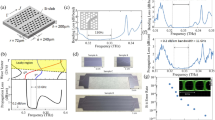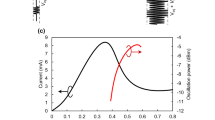Abstract
We propose a resonant tunneling diode (RTD)-based relaxation oscillator and an oscillator-based terahertz (THz) wireless link that compensate for shortfalls in RF-oscillator emission power by adding several relaxation carrier wave harmonic modes. We believe that the proposed link can perform as well as or superior to large component-based wireless links that suppress power dissipation using collimating lenses and/or discrete antennas to add the power output of a relaxation oscillator. This hypothesis is investigated analytically using a physics-based equivalent circuit model of the proposed oscillator and a link budget analysis of the relaxation carrier wave. The model, which incorporates effects such as the non-linearity of the tunneling diode and the electromagnetic properties of the integrated bow-tie antenna on the oscillator, is used to quantitatively investigate the link characteristics in terms of the signal-to-noise ratio (SNR) and other parameters and to demonstrate that, by applying an appropriate device size and number of harmonic modes in the occupied bandwidth, link performance comparable to that of previously reported wireless links can be achieved. Based on these results, we discuss the potential for practical implementation of the proposed link configuration in mobile link applications for use in environments such as the Internet of Things (IoT).













Similar content being viewed by others
References
Cisco, Global mobile data traffic forecast update, 2016-2021., https://www.cisco.com/c/en/us/solutions/collateral/service-provider/visual-networking-index-vni/mobile-white-paper-c11-520862.pdf . Accessed 5 September 2017
J. Mitola and G. Q. IEEE Pers. Commun., https://doi.org/10.1109/98.788210
C. Wang, C. Lin, Q. Chen, X. Deng, and J. Zhang. Proc. 37th Int. Conf. Infrared, MIllim., THz waves, https://doi.org/10.1109/IRMMW-THz.2012.6380109
J. Antes, F. Boes, T. Messinger, U.J. Lewark, T. Mahler, A. Tessmann, R. Henneberger, T. Zwick, and I. Kallfass. IEEE Trans. THz Sci. Technol., https://doi.org/10.1109/TTHZ.2015.2488486
A. Hirata, R. Yamaguchi, T. Kosugi, H. Takahashi, K. Murata, T. Nagatsuma, N. Kukutsu, Y. Kado, N. Iai, S. Okabe, S. Kimura, H. Ikegawa, H. Nishikawa, T. Nakayama, and Inada T. IEEE Trans. Microwave Theory Technol., https://doi.org/10.1109/TMTT.2009.2017256
V. Dyadyuk, J.D. Bunton, J. Pathikulangara, R. Kendall, O. Sevimli, L. Stokes, and Abbott D.A. IEEE Trans. Microwave Theory Technol., https://doi.org/10.1109/TMTT.2007.909875
C. Wang, B. Lu, C. Lin, Q. Chen, L. Miao, X. Deng, and J. Zhang. IEEE Trans. THz Sci. Technol., https://doi.org/10.1109/TTHZ.2013.2293119
C. Jastrow, K. Münter, R. Piesiewicz, T. Kürner, M. Koch, and T. Kleine-Ostmann. IEEE Elecron. Lett., https://doi.org/10.1049/el:20083359
F. Boes, J. Antes, T. Messinger, D. Meier, R. Henneberger, A. Tessmann, and I. Kallfass. IEEE MTT-S Int. Microwave Symp., https://doi.org/10.1109/MWSYM.2015.7166930
D. Lopez-Diaz, S. Koenig, A. Tessmann, F. Boes, J. Antes, I. Kallfass, F. Kurz, F. Poprawa, and R. Henneberger. 11th Euro. Radar Conf., https://doi.org/10.1109/EuRAD.2014.6991283
I. Kallfass, A. Tessmann, J. Antes, D. Lopez-Diaz, M. Kuri, H. Massler, T. Zwick, and A. Leuther. IEEE MTT-S Int. Microwave Symp., https://doi.org/10.1109/MWSYM.2011.5972828
S. Koenig, D. Lopez-Diaz, J. Antes, F. Boes, R. Henneberger, A. Leuther, A. Tessmann, R. Schmogrow, D. Hillerkuss, and R. Palmer. Nature Photon., https://doi.org/10.1038/nphoton.2013.275
H.J. Song, K. Ajito, Y. Muramoto, A. Wakatsuki, T. Nagatsuma, and K. Kukutsu. IEEE Electron. Lett., https://doi.org/10.1049/el.2012.1708
X. Yu, R. Asif, M. Piels, D. Zibar, M. Galili, T. Morioka, P.U. Jepsen, and L.K. Oxenlowe. IEEE Trans. THz Sci. Technol., https://doi.org/10.1109/TTHZ.2016.2599077
G. Ducournau, F. Pavanello, A. Beck, L. Tohme, S. Blin, P. Nouvel, E. Peytavit, M. Zaknoune, P. Szriftgiser, and J.F. Lampin. IEEE Electron. Lett., https://doi.org/10.1049/el.2013.3796
T. Nagatsuma, S. Horiguchi, Y. Minamikata, Y. Yoshimizu, S. Hisatake, S. Kuwano, N. Yoshimoto, J. Terada, and H. Takahashi. Opt. Express, https://doi.org/10.1364/OE.21.023736
G. Ducournau, K. Engenhardt, P. Szriftgiser, D. Bacquet, M. Zaknoune, R. Kassi, E. Lecomte, and J.F. Lampin. IEEE Electron. Lett., https://doi.org/10.1049/el.2015.0702
A. Kanno, K. Inagaki, I. Morohashi, T. Sakamoto, T. Kuri, I. Hosako, T. Kawanishi, Y. Yoshida, and K. Kitayama. IEICE Electron. Express, https://doi.org/10.1587/elex.8.612
N. Oshima, K. Hashimoto, S. Suzuki, and M. Asada. IEEE Electron. Lett., https://doi.org/10.1049/el.2016.3120
K. Ishigaki, M. Shiraishi, S. Suzuki, M. Asada, N. Nishiyama, and S. Arai. IEEE Electron. Lett., https://doi.org/10.1049/el.2012.0849
A. Kanno, P.T. Dat, I. Hosako, T. Kawanishi, and H. Ogawa. IEEE Global Commun. Conf., https://doi.org/10.1109/GLOCOM.2014.7037137
M. Tonouchi. Nature Photon., https://doi.org/10.1038/nphoton.2007.3
T. Nagatsuma. Proc. 20th Int. Conf. Appl Electromagnetics and Commun., 2010
T. Schneider, A. Wiatrek, S. Preussler, M. Grigat, and R.P. Braun. IEEE Trans. THz Sci. Technol., https://doi.org/10.1109/TTHZ.2011.2182118
T. Maekawa, H. Kanaya, S. Suzuki, and M. Asada. 28th Int. Conf. Indium Phosph Relat. Mater., https://doi.org/10.1109/ICIPRM.2016.7528857
Y. Mushiake. IEEE Antennas Propag. Mag., https://doi.org/10.1109/APS.2003.1220041
K. Asakawa, Y. Itagaki, H. Shin-ya, M. Saito, and M. Suhara. IEICE Trans. Electron., https://doi.org/10.1587/transele.E95.C.1376
N. Okumura, K. Asakawa, and M. Suhara. IEICE Trans. Electron., https://doi.org/10.1587/transele.E100.C.430
H. Shin-ya, M. Suhara, N. Asaoka, and M. Naoi. IEICE Trans. Electron., https://doi.org/10.1587/transele.E93.C.1295
H. Yamakura and M. Suhara. IEICE Trans. Electron., https://doi.org/10.1587/transele.E99.C.1312
H. Yamakura and M. Suhara. IEICE Trans. Electron., https://doi.org/10.1587/transele.E100.C.632
M. Suhara, Y. Kato, H. Yamakura, and K. Asakawa. AIUB J. Sci, Eng., 15(1) 1–4 (2016)
H. Yamakura, Y. Ishiguro, Y. Kato, and M. Suhara. Proc. of 41th Int. Conf. Infrared, Millimeter, and Terahertz waves, https://doi.org/10.1109/IRMMW-THz.2016.7758647
I. Bahl and P. Bhartia. Microwave solid state circuit design 2nd edn. (Wiley, New York, 2015), pp. 59
D. Hofmann, G. Müller, and N. Streckfuß. Appl. Phys. A, https://doi.org/10.1007/BF00618891
S.H. Kim, J.G. Fossum, and J.W. Yang. IEEE Trans. Electron Devices, https://doi.org/10.1109/TED.20006.880369
J. Kennedy and R. Eberhart. Proc. of IEEE Inter. Conf. Neural Networks, https://doi.org/10.1109/ICNN.1995.488968
H. Tomioka, M. Suhara, and T. Okumura. IEICE Trans. Electron., https://doi.org/10.1587/transele.E92.C.269
M. Reddy, S.C. Martin, A.C. Molnar, R.E. Muller, R.P. Smith, P.H. Siegel, M.J. Mondry, M.J.W. Rodwell, H. Kroemer, and S.J. Allen. IEEE Electron Device Lett., https://doi.org/10.1109/55.568771
A. Ludwig. IEEE Trans. Antenna and Propag., https://doi.org/10.1109/TAP.1971.1139909
R.P. Meys. IEEE Ant. Propag. Mag., https://doi.org/10.1109/74.848947
Y. Kawano, H. Matsumura, S. Shiba, M. Sato, T. Suzuki, Y. Nakasha, T. Takahashi, K. Makiyama, T. Iwai, and N. Hara. Euro. Microwave Conf., https://doi.org/10.1109/EuMC.2015.7345825
V.S. Mottonen and A.V. Raisanen. 34th Euro. Mocrowave Conf., https://doi.org/10.1109/APS.2013.6711794
Y. Akaiwa. Introduction to digital mobile communication (Wiley, New York, 2015)
I. Watanabe, Y. Yamashita, A. Endoh, S. Hara, A. Kasamatsu, I. Hosako, H. Hamada, T. Kosugi, M. Yaita, A.E. Moutaouakil, H. Matsuzaki, O. Kagami, T. Takahashi, Y. Kawano, Y. Nakasha, N. Hara, D. Tsuji, K. Isono, S. Fujikawa, and H.I. Fujishiro. IEEE Compd. Semicond. Integr. Circuit Symp., https://doi.org/10.1109/CSICS.2016.7751063
G.P. Agrawal. Fiber-optic communication systems, 3rd edn., (Wiley, New York, 2011).
G. Keller, A.T. Kamgaing, B. Munstermann, W. Prost, F.-J. Tegude, and M. Suhara. 25th Int. Conf. Indium Phosph Relat. Mater., https://doi.org/10.1109/ICIPRM.2013.6562641
N. Okumura, K. Asakawa, and M. Suhara. 28th Int. Conf. Indium Phosph Relat. Mater., https://doi.org/10.1109/ICIPRM.2016.7528591
Author information
Authors and Affiliations
Corresponding author
Appendices
Appendix A: Equivalent Circuit Parameters
Table 3 summarizes all of the equivalent circuit parameters and their basic physics with respect to antenna size, D, and line width, wshunt. As the EM field distribution around/on the oscillator is specific and complicated, it was quite difficult to evaluate the values of several parameters, whose “physics” states are therefore given as “N/A.”
Appendix B: Definitions of the Radiation Efficiency
In the case of the EM simulation, the radiation efficiency, ηEM(ω, D, wshunt), is defined as follows:
Prad(EM)(ω, D, wshunt) is the surface integral of the Poynting power on the radiated field.
Pin(EM)(ω, D, wshunt) is given by,
where \(\tilde {{\Gamma }}_{\text {EM}}(\omega ,D,w_{shunt})\) is the reflection coefficient seen from the a-a′ port.
For the circuit analysis, the radiation efficiency, ηcir(ω, D, wshunt), is described as,
where
is the power consumption by the radiated resistance, Rrad(D, wshunt). \(\tilde {V}_{rad}(\omega ,D,w_{shunt})\) is applied to Rrad(D, wshunt), depicted in Fig. 3a. The input power, Pin(cir)(ω, D, wshunt), is given by,
where \(\tilde {V}_{in(\text {cir})}(\omega ,D,w_{shunt})\) and \(\tilde {I}_{in(\text {cir})}(\omega ,D,w_{shunt})\) are defined by,
where Zin(cir)(ω, D, wshunt) indicates the impedance seen from the a-a′ port.
Appendix C: Fundamental Equations for Oscillation Analysis
We derived simultaneous differential equations for the variables of the equivalent circuit shown in Fig. 5. All of the oscillation characteristics presented in this paper were analyzed by solving these equations. The numerical calculations were carried out using the fourth-order Runge-Kutta method:
where the variable A is defined as \( \displaystyle A \equiv \frac {d i_{gap}}{dt}\).
where irad can be defined by,
Rights and permissions
About this article
Cite this article
Yamakura, H., Suhara, M. Proposal of Bow-Tie Antenna-Integrated Resonant Tunneling Diode Transmitter Utilizing Relaxation Oscillations and Its Application to Short-Distance Wireless Communications. J Infrared Milli Terahz Waves 39, 1087–1111 (2018). https://doi.org/10.1007/s10762-018-0518-y
Received:
Accepted:
Published:
Issue Date:
DOI: https://doi.org/10.1007/s10762-018-0518-y




